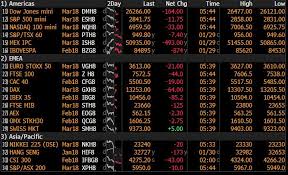An Inverted Yield Curve, a Predictor of Recessions, Has the Stock Market Spooked

For the first time in a while, stock market investors are being spooked this week by what’s happening in the bond market. And the reason has something to do with an occurrence that is not exactly in the everyday investor’s lexicon: an inverted yield curve.
Put simply, an inverted yield curve happens when bond yields at the short end of the bond spectrum rise above those at the long end. Usually, the bond market focuses on the difference between the yields on U.S. Treasury two-year notes and those for 10-year notes. When the yield curve inverts, it means the two-year notes pay bondholders more in interest than 10-year notes do, something that’s both rare and counterintuitive.
For economists and investors, it’s a loud warning about the economy’s outlook. One portfolio manager called the inverted yield curve a “harbinger of doom.” It has a scarily accurate track record of predicting economic recessions, which in past decades have arrived six months to two years after an inversion.
“Every U.S. recession in the past 60 years was preceded by a negative term spread, that is, an inverted yield curve. Furthermore, a negative term spread was always followed by an economic slowdown and, except for one time, by a recession,” Michael Bauer and Thomas Mertens, two Federal Reserve research advisors in San Francisco, wrote in a March paper.
And while interest rates have been unusually low for most of the past decade, Bauer and Mertens believe the prophetic power of the inverted curve still applies. “While the current environment is somewhat special—with low interest rates and risk premiums—the power of the term spread to predict economic slowdowns appears intact,” their paper said.
Typically, the yield curve slopes upwards over time, especially in times of strong economic growth. That’s because the longer it takes a bond to mature, the higher the yields investors demand as a protection against inflation. But long-term bond yields have been lower this year, amid concerns about the U.S. economic outlook in coming years. Meanwhile, the Fed has pushed short-term interest rates up, bringing them closer to—and now, in some cases, above—longer-term yields.
The difference between the two-year and the 10-year Treasury yields hasn’t yet inverted, although it has flattened to 11 basis points—that is, 11 hundredths of a percent—from 25 basis points last Wednesday. But on Monday, the yields on five-year Treasury notes fell below those on three-year notes, an inversion that hasn’t happened since 2007.
That hardly ensures that a recession is coming, let alone one as severe as the Great Recession a decade ago. But it has the bond and stock markets both worried that the classic two-year/10-year inversion is also coming. On Tuesday, the Dow Jones Industrial Average fell nearly 800 points, or 3.1%, largely in response to recession fears stoked by recent changes in the yield curve.
That the lower portion of the yield curve has inverted amid signs that the global economy is slowing is especially worrisome. Many market participants are now watching to see how the Fed reacts to that inversion, along with whether the two-year and 10-year yields will also invert.
“My bigger-term thought is the curve has to invert, and it’s going to happen sooner than people think. If twos and tens invert between now and Dec. 18, the Federal Reserve is going to have to take out some of the hikes next year—or they should do it,” Joseph Lavorgna, chief U.S. economist at Natixis, told Reuters. “I’m worried that they won’t.”








